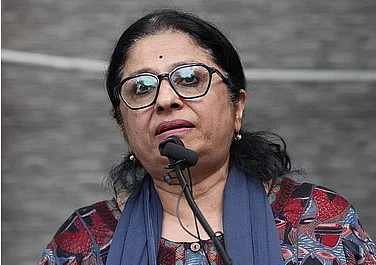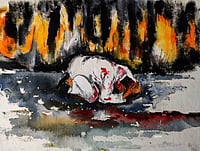Times have changed, and so have generations, practices and traditions. But, here in the mountain district of Kullu — where the Gods and deities are worshipped in their living forms, the weeklong Kullu Dussehra, currently underway at iconic Dhalpur maidan, is more about people’s solemn faith in deity-power and their unflinching religious beliefs.
Unlike rest of India — where Dussehra symbolises the victory of Lord Rama against Ravana and marked by burning of giant effigies or display of weapons — swords, maces, bows and arrows, here the extravaganza is about arrival of Lord Raghunath’s traditional Rath Yatra — a wooden chariot and more than 300 local deities converting the historic Dhalpur maidan into a Divine congregation, for full seven days. It is also a perfect blend of ancient culture, religious fervour and practices.
The event also marked the play of traditional musical instruments and dances in local Pahari attires.

The deities, brought in palanquins in their best religious fineries, are accompanied by hundreds of followers — who come from all over Kullu valley on foot, covering distances as long as 200 km, through the toughest mountain passes and rivulets. They pay obeisance to Raghunath ji and camp at Dhalpur ground for the next seven days even as lakhs of people, tourists including foreigners, become part of daily rituals.
Maheshwar Singh, the scion of Kullu’s royal family, who is ‘Chharibardar’ – Chief caretaker of Lord Raghunath (another name of Lord Rama) – admits that “participation of more than 300 deities this year, despite Kullu valley having seen unrelenting rains, floods, landslides and natural calamities, is a clear indication about people’s faith in the deity culture practised for generations. We are praying to deities to relent and protect us against such disasters”.
The opening day of Dussehra, which began after the arrival of Rangunath’s idol in a special chariot from its temple at Sultanpur ground, was marked by a massive sea of humanity reaching the venue. After two years of the Covid crisis and thereafter, state assembly elections in 2022, the Kullu Dussehra this year was different in many ways more than the high festivity and higher participation of deities.

Says Surat Singh Thakur, a professor of music, who has authored several books on cultural tradition and folks, says. “After the destruction in Kullu, the deities have pronounced that it was just a reflection of what is going to come up in the next few years. People have played havoc with nature due to greed. Destroyed forests, cut down trees, built buildings in rivers—blocking their natural flows and ignoring scientific warnings.”
It's 'dev-sanskriti' that binds the people of Kullu, and most of their rituals, ceremonies and even marriage are decided by the deities/devtas. No one can defy a deity's orders or have to pay a heavy price for it unless he/she is pardoned.
The massive response to Dussehra celebrations is due to fears that if they (people) don’t care to protect nature, respect the deities and adhere to their warning, Kullu and its people will be safe, he maintains.
Moreover, the local administration has also made arrangements quite better than in earlier years. “This year's celebrations are certainly different,” Thakur claims.
Aqil Khan, a media professional at Kullu, feels that Kullu Dussehra came after most farmers, orchardists and peasants had done harvesting their produce. The crowd was overwhelming and also highly enthusiastic, as most pictures and videos were also shown after Rathyatra.
In fact, Kullu Dussehra doesn't mark the end of Vijayadashami, but the beginning of celebrations that goes on for a week.
Chief Parliamentary Secretary Sunder Singh Thakur, who is also a local MLA, being Chairman of the Dussehra Management Committee has also tried to bring some new elements, including the participation of cultural troupes from 12 countries, for the first time, making Dussehra truly international.

The Legend
The history of Kullu Dussehra dates back to the 17th century when local King Jagat Singh installed an idol of Raghunath on his throne as a mark of penance. After this, Lord Raghunath was declared the ruling deity of the Valley.
The legend goes that after this return from a pilgrimage to Maharishi, Jamdagni went to his hermitage at Malana. On his head, he carried a basket filled with eighteen images of different gods. Crossing through Chanderkhani pass, he came upon a fierce storm.
Struggling to stay on his feet, Maharishi Jamdagni's basket was thrown from his head, scattering the images to many distant places. Hill people, finding these images, saw them take shape or form as Gods and began to worship them. Legend has it that deity worship began in the Kullu Valley.
Raja Jagat Singh ruled over the prosperous and beautiful kingdom of Kullu (1637-62). One day, he learned of a peasant named Durgadatta, who possessed many beautiful pearls. The king, in his greed, ordered Durgadutta to hand over his pearls or be hanged.
Knowing of his inevitable fate at the hands of the king, Durgadatta threw himself on the fire and cursed the king, "Whenever you eat, your rice will appear as worms, and water will appear as blood".
Doomed by his fate, the Raja sought solace and sought out advice from a Ramanandi saint, Krishnadas Payahari, who told him that in order to eradicate the curse, he must retrieve the deity of Ragunath from Ram's kingdom—Ayodhya. A desperate king sent a Brahmin to Ayodhya, who stole the deity and set out on his journey back to Kullu.

The people of Ayodhya, finding their beloved Ragunath missing, set out in search of the Kullu Brahmin. On the banks of the Saryu River, they approached the Brahmin and asked him why he had taken Raghunath ji. The Brahmin recounted the story of the Kullu king.
The people of Ayodhya attempted to lift Ragunath, but their deity became incredibly heavy when headed back towards Ayodhya and became very light when headed to Kullu. On reaching Kullu, Ragunath was installed as the reigning deity of the Kullu kingdom.
Since then, Jagat Singh became Lord Ragunath's regent, and the tradition has continued as the scion of Kullu’s king continues to remain Chief Caretaker of the Idol till now.
King, Gods and Politics
Kullu Dussehra is not free from politics even as it also reflects the deep-rooted faith of people in religious beliefs that even manifest during the festival.
Maheshwar Singh, the chief caretaker of Lord Raghunath, is a former BJP MP, a senior politician who has not hidden his electoral ambitions for the next Lok Sabha poll. He remains a dominant figure in the scene, influencing the ‘kardars’—all caretakers of local deities. His writing runs large and, come time, invokes “deities” dictates, which the local administration and the government are supposed to adhere to.
Only recently, a Rs 200 crore ambitious ropeway project, approved by the Centre, for Bijli Mahadev temple (2,460-meter elevation) got scuttled when the government was told that deities’ were opposed to the project.

In 2003-04, a Rs 5,000-crore Himalayan Ski Village project at Manali, conceived by Alfred Ford, the great-grandson of the legendary Henry Ford, could not see the light of the day even as it was the biggest foreign investment in Himachal Pradesh in the tourism sector .
Maheshwar Singh led the protests and held a congregation of 400 deities at Naggar to oppose the project, and it was eventually scrapped.
Former Chief Minister Virbhadra Singh, uncomfortable with Maheshwar Singh’s influence as ‘Chief Kardar’ of Lord Raghunath and also a potential political figure, ordered the take-over of Lord Raghunath temple by the government. However, the move failed after the High Court intervention. The case is still pending in the Supreme Court.
Asked how much politics is dominant in Kullu Dussehra, Maheshwar Singh says he can’t be stripped of his standing as a scion of Kullu’s erstwhile king till his death. “What happened thereafter, I don't know,” he says, yet makes it clear that the Congress governments and the Congress leaders had been interfering in religious practices/his role as ‘Charibardar’ of Lord Raghunath. However, the curse of their actions finished them politically. One such leader he mentioned, Lal Chand Prarthi—a former minister in Dr Y S Parmar's cabinet, was also instrumental in ordering police firing in 1972 during the festival.
New Trend
There is a generational change in Kullu Valley. Most deities reaching for Dussehra are accompanied by youths as the elders stay back home. The advent of social media and digital technologies has attracted youths to make Instagram and Facebook accounts of their deities. Every day, they upload events from the Dussehra ground.
Bhenuj Thakur, a college student who handles social media accounts of local devta/deity, says that every day, they get 500 to 700 hits on their Instagram and Facebook accounts. Many devotees who could not accompany are watching reels and live updates from the ground on all ceremonies and rituals being performed.
“Even those followers of devta/deity, either in foreign countries or elsewhere in India, are also connected to us through social media. This is helping us to promote Dev-Sanskriti beyond the boundaries of Kullu,” says Jagdish Sharma, an oracle (locally called Gurr) of a deity from Banjar (Kullu).

























